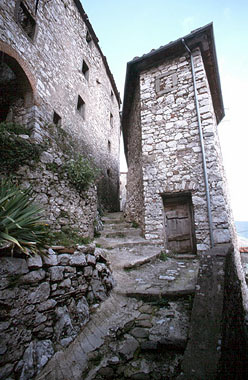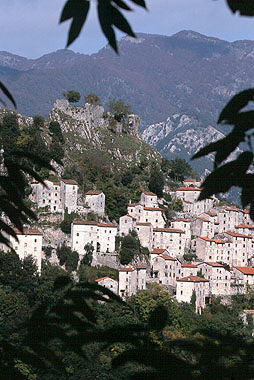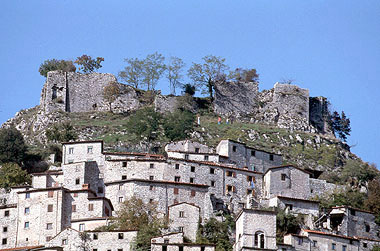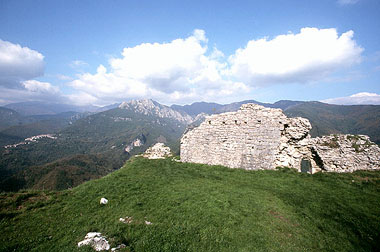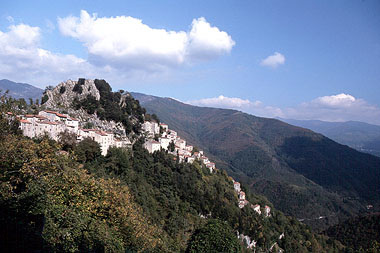Rocca of Lucchio

Information
Foundation:
XI-XII century
District/Location:
Bagni di Lucca, locality Lucchio
District:
Mediavalle

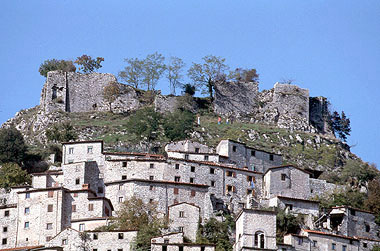
The rocca of Lucchio is situated at the top of a spur of rock jutting out over the valley of the Lima and the road running along it.
The village lies at the foot of the fortification, stretched along a very steep slope so that the houses appear to be built one upon the other.
The setting is of exceptional beauty and from here it is possible to see Mount Balzonero and the nearby summits of the Apennine.
For the rocca an almost impregnable place dominating the river and the road below was chosen for strategic reasons. The garrison was the furthest outpost controlling the territory of the Republic of Lucca towards the Apennine above Pistoia and the Florentine domains.
The rocca underwent several transformations in the course of the centuries; it became private property in the 19th, when the surrounding land was used as farmland.
The village lies at the foot of the fortification, stretched along a very steep slope so that the houses appear to be built one upon the other.
The setting is of exceptional beauty and from here it is possible to see Mount Balzonero and the nearby summits of the Apennine.
For the rocca an almost impregnable place dominating the river and the road below was chosen for strategic reasons. The garrison was the furthest outpost controlling the territory of the Republic of Lucca towards the Apennine above Pistoia and the Florentine domains.
The rocca underwent several transformations in the course of the centuries; it became private property in the 19th, when the surrounding land was used as farmland.
55022 Lucchio LU
Parts of the wall enceinte are well preserved, while others are in such bad condition that they represent a threat for the houses below and badly need repair.
The rocca is now a ruin in spite of repairs made in the course of time by private citizens; indeed, the structure has been gradually demolished together with parts of the wall that threatened the village below.
The rocca is now a ruin in spite of repairs made in the course of time by private citizens; indeed, the structure has been gradually demolished together with parts of the wall that threatened the village below.
The rocca of Lucchio, for its exceptionally strong strategic position, was probably fortified early in the Middle Ages, though the first written documents are much later; the characteristics of the structure make it datable to the XIth-XIIth century.
The rocca of Lucchio is mentioned for the first time in a charter of 1327; in 1385 and again in 1390 the Town Council of the Lucchese Republic (the so called 'Consiglio Generale'), considering its strategic role, decided to carry out renovation and repair works and appoint the commander of the garrison.
Since access to the rocca is very difficult, it is probable that the village developed later around the fortress to provide for the needs of the garrison rather than as a settlement of its own; for this reason the community is mentioned in the sources only much later.
It became, together with Montefegatesi on the opposite bank of the torrent Lima, the north-eastern bulwark of the Republic of Lucca; in consideration of its important strategic role Lucchio was granted a number of privileges, in particular in 1437 after the heroic resistance of its inhabitants against the Florentine invaders.
The fortress of Lucchio was besieged time after time, while in 1525 the villagers betrayed the government and offered shelter to two prominent members of the Di Poggio family in their attempt to seize power over the town.
In 1645 the walls were reinforced: however, in that period the fortress was no longer of particular strategic importance; the post of keeper of the castle was abolished and maintenance was left in the hands of the poor community.
So began its inevitable decline: at the end of the XVIIth century the construction of outer barbicans was decided to support the walls and prevent them from collapsing on the houses below.
Under Carlo Lodovico di Borbone the rocca, that had by then lost its military function and was in a very bad state, was auctioned and sold to a local family, the Pacini; the building that had formerly housed the garrison was converted to private residence and the surrounding grounds became farmland.
The rocca of Lucchio is mentioned for the first time in a charter of 1327; in 1385 and again in 1390 the Town Council of the Lucchese Republic (the so called 'Consiglio Generale'), considering its strategic role, decided to carry out renovation and repair works and appoint the commander of the garrison.
Since access to the rocca is very difficult, it is probable that the village developed later around the fortress to provide for the needs of the garrison rather than as a settlement of its own; for this reason the community is mentioned in the sources only much later.
It became, together with Montefegatesi on the opposite bank of the torrent Lima, the north-eastern bulwark of the Republic of Lucca; in consideration of its important strategic role Lucchio was granted a number of privileges, in particular in 1437 after the heroic resistance of its inhabitants against the Florentine invaders.
The fortress of Lucchio was besieged time after time, while in 1525 the villagers betrayed the government and offered shelter to two prominent members of the Di Poggio family in their attempt to seize power over the town.
In 1645 the walls were reinforced: however, in that period the fortress was no longer of particular strategic importance; the post of keeper of the castle was abolished and maintenance was left in the hands of the poor community.
So began its inevitable decline: at the end of the XVIIth century the construction of outer barbicans was decided to support the walls and prevent them from collapsing on the houses below.
Under Carlo Lodovico di Borbone the rocca, that had by then lost its military function and was in a very bad state, was auctioned and sold to a local family, the Pacini; the building that had formerly housed the garrison was converted to private residence and the surrounding grounds became farmland.
- CHERUBINI B., I Bagni di Lucca, Lucca Maria Pacini Fazzi editore 1981
Scopri altre attrazioni vicino a Rocca of Lucchio
See allYou may also like..
See allFind more
0









